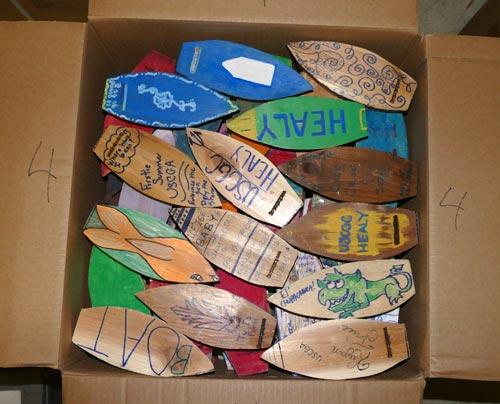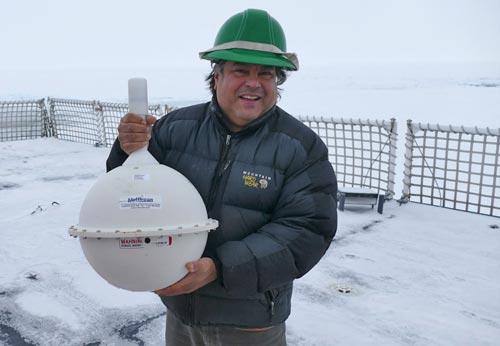Cruise Day 39
Speed 0 knots (kts) (on station)
Course n/a
Location Alpha Ridge, ~290 nautical miles south of N. Pole
Depth 2190 m
GO DEEPER DISCUSSION: (see previous journal for the questions.)
Everyone on the science team working outside on the ice or on deck wears an orange Mustang suit. These are float suits, provide a lot of insulation, and shed water. When I was on the ice today in -12° F wind chill I was glad to have the Mustang suit atop my other layers to keep me snug!
TODAY’S JOURNAL:
The super station is progressing well, with only deep McClane filter pumping and a deep ODF rosette cast left to work on before pulling up stakes and heading farther south. We did another ice station today while the deep pumping was going on, a time-saving measure. Last night and today felt about as cold as it has gotten on this trip, with wind chills from -8° F to -12° F depending on the wind’s strength since last night. When we were bringing up the GEOTRACES rosette just before midnight the block (a pulley hung from the aft A-frame) froze up, and the ice had to be chipped out with a pointed hook on a long pole before recovery could continue.
I also saw something last night that I hadn’t seen for weeks – a sunset! The sun actually set two nights ago for the first time in a while but was hidden by clouds. Last night, though, it sloped low across the sky angling towards the horizon, creating neat optical effects as it went down over a few hours. For a while there were two spectacular halo arcs bracketing the sun that looked like slightly curved rainbows rising up from the horizon right and left of the sun. Simultaneously, there were pillars of light above and below the sun. These effects are all from ice crystals in the air – even though the sky was clear overhead it got so cold that tiny ice crystals were precipitating out of the air like microscopic diamond dust. As the sun dipped to the horizon it turned red, with a red pillar shooting up above it while the patchy clouds low on the horizon seemed to be reflecting fire from below. Finally, the clouds above the set sun glowed as though they enveloped an erupting volcano, with an open lead reflecting the color as though it was a river of lava running away from the eruption.


In Seattle we loaded a cargo of wooden boats that were decorated by students from schools participating in the Float Your Boat project. Each boat that a student worked on is packed into a large box with a batch of other boats, and will be put on an ice floe along with an SVP (Surface Velocity Program) buoy. These buoys report their position and temperature back to a satellite that relays the data to scientists tracking their movement. So at least for the coming winter, boxes of Float Your Boats will be trackable as long as the buoy deployed with each batch is transmitting. We put out boxes #1 and #2 on an ice floe four days ago, and left boxes #3 and #4 on the ice today as we concluded the ice station. Boxes 5, 6, and 7 await suitable ice down the line, and then they will all be adrift on the Arctic ice pack for the winter or perhaps longer.



Eventually, the ice will melt from under the boxes of boats, releasing them into the Arctic Ocean to drift as the cardboard disintegrates. If they eventually wash ashore and are picked up, the finder can report where the boat made landfall to the Float Your Boat web page. Link on over to see what’s going on with this project and to watch how the SVP buoys are moving with the pack ice after we drop them off!

GO DEEPER!
If the Float Your Boats stay in the Arctic Ocean, what are the possible countries where they could wash ashore?
Aloft Con web cam updated every hour
Healy Track
That's all for now. Best- Bill


Comments